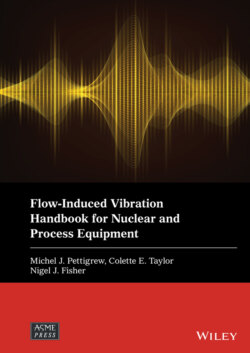Читать книгу Flow-Induced Vibration Handbook for Nuclear and Process Equipment - Группа авторов - Страница 14
1.1 Introduction
ОглавлениеExcessive flow‐induced vibration must be avoided in process and nuclear system components. That is the purpose of this handbook. The term “process components” is used generally here to describe nuclear reactor internals, nuclear fuels, piping systems, and all shell‐and‐tube heat exchangers, including nuclear steam generators, power plant condensers, boilers, coolers, etc. Higher heat‐transfer performance often requires higher flow velocities and more structural supports. On the other hand, additional supports may increase pressure drop and costs. The combination of high flow velocities and inadequate structural support may lead to excessive tube vibration. This vibration can cause failures by fatigue or fretting wear. Failures are very undesirable in terms of repair costs and lost production, particularly for high‐capital‐cost plants such as nuclear power stations, petroleum refineries and oil exploitation platforms. To prevent these problems at the design stage, a thorough flow‐induced vibration analysis is recommended. Such analysis requires good understanding of the dynamic parameters and vibration excitation mechanisms that govern flow‐induced vibration.
This handbook covers all relevant aspects of component vibration technology, namely: examples of vibration failures, flow analysis, and vibration excitation and damping mechanisms. The latter includes fluidelastic instability, periodic wake shedding, acoustic resonance, random turbulence, flow‐induced vibration analysis and fretting‐wear predictions.
Chapter 2 is an overview of flow‐induced vibration technology. The reader should start with this chapter. In many cases, Chapter 2 will be sufficient to provide the required information. Each aspect of the technology is covered in detail in the succeeding chapters. Typically, each chapter includes a review of the state of the art, available laboratory data, brief review of theoretical considerations and modeling, parametric analysis, recommendations for design, and sample calculations.
The performance of process components is often limited by excessive vibration in a localized area, e.g., near inlets, outlets, etc. The combination of detailed flow calculations and vibration technology allows the designer to avoid such problems. Flow velocities and support design can be optimized to allow maximum heat transfer in all regions of process components, resulting in higher heat‐transfer performance, less corrosion and fouling problems and reduced component size. The latter means capital cost reduction and a more competitive manufacturing industry.
This handbook is for the practicing engineer who is designing or troubleshooting nuclear and process system components. Design guidelines are proposed based on extensive analysis of the literature and, in particular, on experimental data obtained in the field and at the Canadian Nuclear Laboratories of Atomic Energy of Canada Limited at Chalk River, Ontario, Canada. Although it is not intended as an undergraduate text book, it could be useful as a source of design data and practical examples. To assist students and new design engineers, the example calculations provided throughout this handbook are supplemented and presented with more explanation in Appendix A.
There are already several useful books on flow‐induced vibration, e.g. Au‐Yang (2001), Blevins (1990), Chen (1987), Kaneko et al (2014), Naudascher and Rockwell (1994), and Païdoussis (1998). So, why another one in the form of a handbook? This book is complementary to the above books for the following reasons. This book has greater emphasis on design guidelines. Much experimental data is presented in the form of comprehensive data bases that include a significant number of two‐phase flow results. Particular attention is given to damping in single‐ and two‐phase flow, two‐phase flow‐induced vibration mechanisms such as fluidelastic instability and random turbulence excitation, and the prediction of fretting‐wear damage. Simple examples of calculations are given throughout the handbook.
